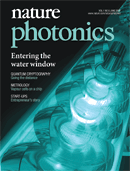
Scientists from DESY and their collaborators from 26 universities or institutes reported on the performance of the free-electron laser FLASH at DESY. The laser was operated at a wavelength of 13.7 nm where unprecedented peak and average powers for a coherent extreme-ultraviolet radiation source have been measured.
In the saturation regime, the peak energy approached 170 microJ for individual pulses, and the average energy per pulse reached 70 microJ. The pulse duration was in the region of 10 fs, and peak powers of 10 GW were achieved.
At a pulse repetition frequency of 700 pulses per second, the average extreme-ultraviolet power reached 20 mW. The output beam also contained a significant contribution from odd harmonics of approximately 0.6% and 0.03% for the 3rd (4.6 nm) and the 5th (2.75 nm) harmonics, respectively. At 2.75 nm the 5th harmonic of the radiation reaches deep into the water window, a wavelength range that is crucially important for the investigation of biological samples because the water within the biological specimens becomes transparent.
Facilities like FLASH are opening windows into unknown territories: soon x-ray free electron lasers will enable scientists to probe ultrafast physical, chemical and biochemical processes at atomic resolution.
(partly from: Abstract of the article)
| Nature Photonics online |
|





